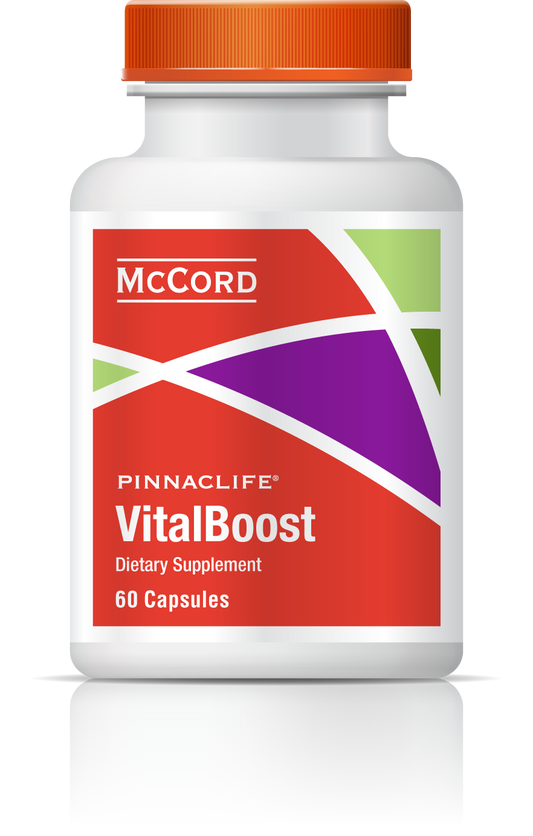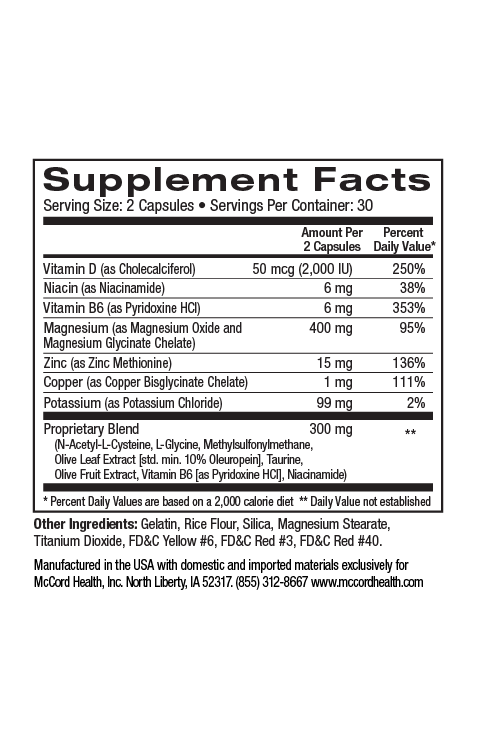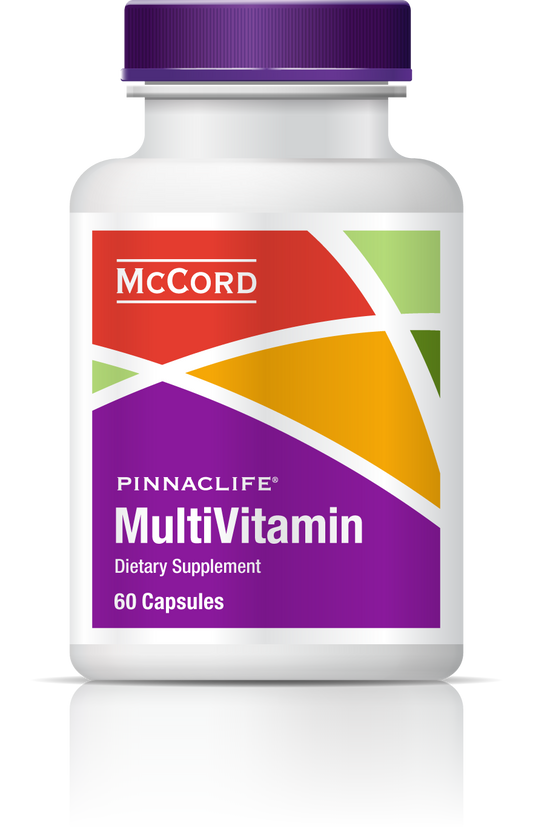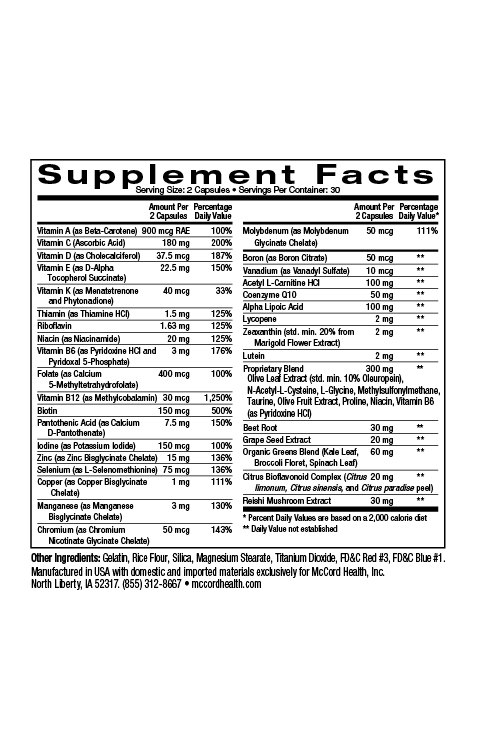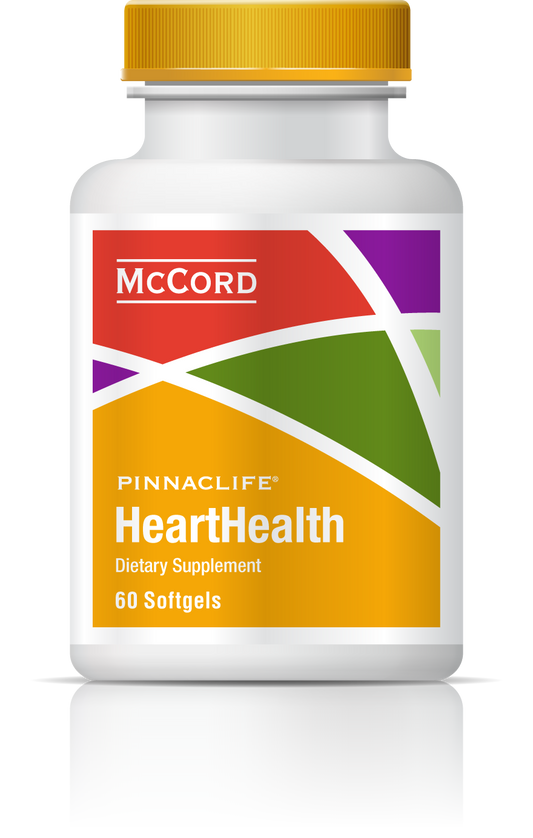Cardiovascular disease is a common and complex health problem with many forms and processes involved, including inflammation and endothelial dysfunction that are associated with oxidative stress. Pinnaclife® HeartHealth with Proprietary Blend includes several ingredients that decrease inflammation and counteract oxidative stress including the potent olive polyphenols hydroxytyrosol and oleuropein. These important olive polyphenols have demonstrated activity against many of the various components of cardiovascular disease including hypertension and endothelial dysfunction. Proper functioning of mitochondria (the powerhouses of cells) is critical to heart health and several ingredients including the olive polyphenols in Proprietary Blend have also been found to increase mitochondrial function.
- More than one-third of Americans currently have or did have at least one form of cardiovascular disease
- Inflammation, oxidative stress, and endothelial dysfunction are important processes that are involved with cardiovascular disease
- The potent olive polyphenols hydroxytyrosol and oleuropein found in Proprietary Blend and Pinnaclife® HeartHealth help decrease inflammation and oxidative stress
- Olive polyphenols have demonstrated protective effects against many components of cardiovascular disease including against endothelial dysfunction
- Other ingredients besides olive polyphenols found in Proprietary Blend and HeartHealth also decrease endothelial dysfunction and help increase mitochondrial function that is critical for heart health
Greater than 1 in 3 Americans have or have had at least one form of cardiovascular disease, and in fact by 2030, it is estimated that 43.9% of the U.S. population will have cardiovascular disease1. Cardiovascular disease encompasses a large range of complex disease forms that include hypertension (high blood pressure), atherosclerosis, stroke, myocardial infarction, and heart failure. There are many causes for the various forms of cardiovascular disease; however, there are some common processes that all forms tend to include such as inflammation, endothelial dysfunction, and metabolic impairments associated with metabolic syndrome, obesity, and/or dyslipidemia2,3.
Accumulating evidence suggests that olive polyphenols in olive oil convey beneficial effects against these processes, indicating olive polyphenols like hydroxytyrosol and oleuropein found in Pinnaclife® HeartHealth and Proprietary Blend can help address the causative and contributing factors in a wide variety of cardiovascular disorders4,5. In fact, olive polyphenols are thought to play a significant role in the improved cardiovascular health found in people who follow the Mediterranean diet that incorporates significant amounts of olive oil3. Moreover, clinical trials that have examined the effects of olive oil on cardiovascular disease and related health problems have indicated that the consumption of olive oil can provide protection against various aspects of cardiovascular disease6,7.
Pinnaclife® HeartHealth with Proprietary Blend includes the powerful ingredients that have important activities against inflammation that is associated with oxidative stress. Oxidative stress results from the inability of cells to eliminate free radicals known as reactive oxygen species (ROS) using the natural defense system that includes defense enzymes such as superoxide dismutase (SOD)8. In addition to the potent olive polyphenols hydroxytyrosol and oleuropein, Proprietary Blend includes methylsulfonyl methane (MSM), N-acetylcysteine (NAC), and taurine that have been found to decrease inflammation and oxidative stress9-18. Hydroxytyrosol, oleuropein, and NAC have also been shown to activate manganese (Mn)SOD19-21.
In an interesting study, it was discovered that hydroxytyrosol was able to reverse chronic inflammation and oxidative stress that can lead to the development of cardiovascular, hepatic, and metabolic syndrome from a high-carbohydrate and high-fat diet22. Olive polyphenols have also been shown to improve vascular function and reduce inflammation and fibrosis in heart tissues, reduce left ventricle stiffness, and improve aortic reactivity, while simultaneously improving abdominal fat deposition, plasma triglycerides, total cholesterol, glucose tolerance, and insulin sensitivity22,23.
Moreover, the anti-inflammatory and antioxidant properties of oleuropein appear to contribute to the antithrombotic and anti-atherogenic properties of oleuropein, which have also been shown to have beneficial effects in dyslipidemia and preventing LDL oxidation24. In addition, studies in hypertensive patients have shown therapeutic benefits from high-phenolic olive oil that was not observed with low-phenolic olive oil, leading researchers to attribute the observed effects to the natural polyphenols25.
Furthermore, numerous studies have indicated that olive leaf extract rich in hydroxytyrosol and oleuropein may decrease cardiovascular disease risk through its potential to induce anti-atherosclerotic, hypotensive, antioxidant, anti-inflammatory and hypocholestemic effects26. In addition, oleuropein was demonstrated to have cardioprotective effects following ischemia and doxorubicin-induced cardiomyopathy4 and oleuropein was shown to have protective effects against myocardial ischemia in a myocardial ischemia/reperfusion model where oleuropein also decreased myocardial infarction size27.
ROS play a critical role in endothelial dysfunction that contributes to atherosclerosis development and cardiovascular disease. Hydroxytyrosol has been shown to reduce ROS levels in vascular endothelial cells28. Hydroxytyrosol has also been shown to decrease endothelial dysfunction29, and hydroxytyrosol has been found to have a protective effect against endothelial dysfunction in human aortic endothelial cells30. In addition, oleuropein was found to restore endothelial progenitor cell function31, taurine was demonstrated to protect against endothelial dysfunction32,33 and evidence suggests that N-acetyl-L-cysteine can improve endothelial dysfunction34.
In response to the high-energy demand in the heart, at least 25% of human heart cells are composed of mitochondria35, the subcellular powerhouses that produce most of the required energy for cells in the form of ATP. Hydroxytyrosol has been shown to decrease mitochondrial dysfunction in a model of toxin-induced heart damage36. Studies have also shown that taurine’s antioxidant activity contributes to improved mitochondrial function37,8 and that NAC improves mitochondrial function33. Pinnaclife® HeartHealth with Proprietary Blend http://www.olivamine.com includes impeccably sourced ingredients that have undergone rigorous scientific review to prove we renew, restore, and repair cells.
References
- Circulation 2015; 131: e1-e294.
- Vascul Pharmacol 2015; 71: 40-56.
- J Clin Endocrinol Metab 2004; 89(6): 2595-2600.
- J Transl Med 2014; 12(1): 219.
- Hell J Nucl Med 2014; 17(Suppl 1): 62-69.
- Int J Mol Sci 2016;17: 843, 1-28.
- Molecules 2016; 21(12): 1734.
- Curr Neuropharmacol 2009; 7: 65-74.
- J Agric Food Chem 2011; 59: 4473-4482.
- Sci Pharm 2010; 78: 133-154.
- Amino Acids 2004; 26: 203-207.
- Nutrients 2017; 9(3): 290, 1-21.
- Life Sci 2015; 121: 110-116.
- Planta Med 2011; 77: 1890-1897.
- Int J Mol Sci 2014; 15: 18508-18524.
- World J Diabetes 2014; 5: 679-710.
- Biol Pharm Bull 2009; 32: 651-656.
- Amino Acids 1996; 10: 59-71.
- Age 2012; 34: 95-109.
- J Biol Regul Homeost Agents 2014; 28: 105-116.
- Cancer Res 2007; 67: 6392-6399.
- J Nutr 2010; 140(5): 946-953.
- PLOS One 2013; 8(3): e57622.
- Int J Mol Sci 2014; 15(10): 18508-18524.
- Pharmacol Res 2007; 55(3): 175-186.
- Eur J Nutr 2017; 56: 1421-1432.
- Int J Mol Med 2018; 42(3): 1034-1043.
- Eur J Pharmacol 2011; 660(2-3): 275-282.
- Oxid Med Cell Longev 2018; ID 9086947, 1-14.
- Mol Nutr Food Res 2015; 59(12): 2523-2536.
- Phytomed 2013; 20: 1088-1094.
- Redox Biol 2014; 2: 971-977.
- Biomed Res 2011; 32: 187-193.
- Transl Psychiatry 2015; 5(1): e492.
- Int J Cardiol 2014; 171: 134-143.
- Biochem Pharmacol 2014; 90: 25-33.
- J Cell Sci 2006; 119: 2855-2862.

